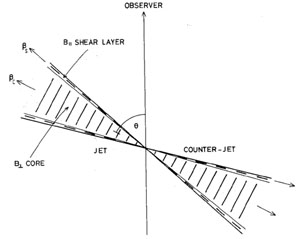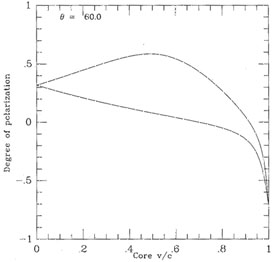


4.3. Are All Strong-Flavor Jets Relativistic?
An extremely interesting recent discovery is that FRI radio sources also show depolarization asymmetry, this time in the sense that the side of the source with the stronger jet base depolarizes less rapidly with increasing wavelength. This result was first tentatively suggested by De Ruiter et al. 1989 and has subsequently been confirmed by Parma et al. 1993 and by a search of the published literature. The asymmetry of FRI jet bases, their association with depolarization asymmetry and indirect arguments from "Unified Models" (e.g. Urry, Padovani & Stickel 1991) all suggest that they may have relativistic bulk speeds. This section summarizes the results of Laing (in preparation), who shows that a simple model of a decelerating, relativistic jet can explain a number of the systematics outlined in Table 1.
The velocity profile and field structure assumed in the model
(Figure 7) have been
suggested previously to explain the observed polarization structure of
FRI radio jets.
Two antiparallel, but otherwise identical jets propagate away from a
galactic nucleus along a direction which makes an angle
 to the line of sight. The jet
cores have velocity
to the line of sight. The jet
cores have velocity
 cc and
contain a magnetic field which has no longitudinal component but is
otherwise
random (Laing 1980).
The surrounding shear layer has velocity
cc and
contain a magnetic field which has no longitudinal component but is
otherwise
random (Laing 1980).
The surrounding shear layer has velocity
 sc
(
sc
( s <
s <
 c) and
its field is entirely longitudinal. Both
c) and
its field is entirely longitudinal. Both
 c and
c and
 s
decrease as the jets propagate away
from the nucleus. Two effects of relativistic aberration cause the
appearance of the
jets to change as they slow down: firstly, the relative flux from the
two components
alters, since their Doppler factors are different and secondly, the
degree of polarization
of radiation from the core varies, since it is viewed at a changing
angle to the line of sight in its rest frame.
s
decrease as the jets propagate away
from the nucleus. Two effects of relativistic aberration cause the
appearance of the
jets to change as they slow down: firstly, the relative flux from the
two components
alters, since their Doppler factors are different and secondly, the
degree of polarization
of radiation from the core varies, since it is viewed at a changing
angle to the line of sight in its rest frame.

|
Figure 7. A sketch of the magnetic-field and velocity structure assumed for the jet model discussed in the text. |
If FRI jets have field and velocity structures of this type and decelerate away from the nucleus, the observable consequences are as follows:
 < 90°) undergo a
field flip from longitudinal to transverse as they slow down, since the
shear layer
is slower than the core and suffers less beaming away from the line of
sight. The
base of the approaching jet is significantly brighter. Thus, with
limited sensitivity,
the source will appear to have a one-sided, B|| jet
base. Figures 8 and
9 illustrate
the dependence of total intensity and degree of polarization (integrated
across the model jet) as a function of core speed for
< 90°) undergo a
field flip from longitudinal to transverse as they slow down, since the
shear layer
is slower than the core and suffers less beaming away from the line of
sight. The
base of the approaching jet is significantly brighter. Thus, with
limited sensitivity,
the source will appear to have a one-sided, B|| jet
base. Figures 8 and
9 illustrate
the dependence of total intensity and degree of polarization (integrated
across the model jet) as a function of core speed for
 = 60°.
= 60°.

|
Figure 9. The dependence of the degree of
polarization on
|
 region of the
approaching jet is also Doppler boosted, but the least
symmetrical emission is the B|| base.
region of the
approaching jet is also Doppler boosted, but the least
symmetrical emission is the B|| base.
 < 30°, giving a
possible explanation for the observed "gaps"
(Bridle & Perley 1984).
The rest-frame surface-brightness falls more rapidly with distance
from the nucleus than appears from observation.
< 30°, giving a
possible explanation for the observed "gaps"
(Bridle & Perley 1984).
The rest-frame surface-brightness falls more rapidly with distance
from the nucleus than appears from observation.
 . These are BL
Lac objects in the unified models. Note that BL Lac objects indeed have
B
. These are BL
Lac objects in the unified models. Note that BL Lac objects indeed have
B jets on
parsec scales
(Roberts et al. 1990).
jets on
parsec scales
(Roberts et al. 1990).
 jets are
always center-brighted but B|| jets can be
limb-brighted, since the
emission from the center must be suppressed for the longitudinal component to
dominate. This is observed in M87
(Owen, Hardee &
Cornwell 1989).
In twin-jet sources, the brighter jet base has a more centrally peaked
brightness distribution and therefore a smaller FWHM (as observed by
De Ruiter et al. 1989).
jets are
always center-brighted but B|| jets can be
limb-brighted, since the
emission from the center must be suppressed for the longitudinal component to
dominate. This is observed in M87
(Owen, Hardee &
Cornwell 1989).
In twin-jet sources, the brighter jet base has a more centrally peaked
brightness distribution and therefore a smaller FWHM (as observed by
De Ruiter et al. 1989).